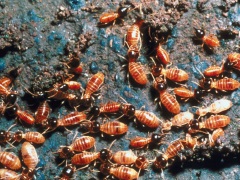Features
Community benefits
Date: 2018-10-29 13:38:28.0
Author: Jon Evans

In the search for enzymes that can break down plant biomass, scientists have long looked in the guts of herbivores such as cows, pandas and termites (see Termite Power). While some of these biomass-degrading enzymes are produced by the animals themselves, most are produced by communities of microorganisms, mainly bacteria, that inhabit the gut. These bacteria get a stable environment and a constant supply of food, while the host animal gets biomass broken down into compounds they can utilize, such as acetate and other volatile fatty acids.
But as well as being a source of useful enzymes for breaking down biomass, these bacterial communities could also offer more direct benefits. If the communities were transferred into bioreactors, then they could potentially convert biomass into a range of useful compounds on an industrial scale and in a single step.
The problem with this approach is that it requires replicating the conditions inside an animal’s gut within a bioreactor, which has proved difficult. As a consequence, when bacterial communities have been transferred from animals such as cows into a bioreactor, they have never worked as well as they do inside the cow’s gut.
To try to find ways to improve this situation, Guillermina Hernandez‑Raquet and colleagues at the University of Toulouse in France decided to investigate exactly what happens to a bacterial community when it is extracted from an animal’s gut and grown in a bioreactor. For this study, they used a bacterial community extracted from the hindgut of the termite Nasutitermes ephratae, which they then grew on wheat straw in a bioreactor.
They used gene sequencing to monitor how the composition of the bacterial community changed over time, and liquid and gas chromatography to monitor how well the community could break down the wheat straw. To vary the conditions slightly, they tested the extracted communities on both sterile and non-sterile wheat straw, with the straw sterilized by heating it at 120°C for 20 minutes.
As Hernandez‑Raquet and her colleagues report in a paper in Biotechnology for Biofuels, the composition of the community quickly changed on being transferred from the termite hindgut to the bioreactor, generally becoming less diverse. Bacteroidetes and Prevotella species became more prevalent, at the expense of Spirochaetes and Fibrobacteres species. This reduction in diversity was more marked in the communities grown on non-sterile wheat straw, presumably because they also had to compete with microbes already present in the straw, which the fast-growing Bacteroidetes and Prevotella species were better able to do.
The change in composition was reflected in the ability of the communities to break down the wheat straw, with the slightly more diverse community grown on the sterile wheat straw proving more effective at doing so. It was able to break down 42% of the wheat straw in 12 days, including 58% of the cellulose and 52% of the hemicellulose, mainly converting them into volatile fatty acids. This made it more effective at breaking down biomass than a bacterial community taken from the gut of a cow and grown in a bioreactor in a previous study.
The community was still much less effective than communities within termite hindguts, which can break down up to 99% of the cellulose and 87% of the hemicellulose in plant biomass. However, as Hernandez‑Raquet and her colleagues conclude, this study shows that even without replicating the exact conditions within an animal’s gut, the conditions in a bioreactor can still be tuned to enhance the break down of biomass by a bacterial community.
Other research groups are already exploring this possibility. This includes a team from the University of Delaware in the US, which recently received a three-year, $1.5 million grant to study the use of microbial communities as a platform for biofuels. “While microbial communities are very common in nature, they are still not widely used in the industry,” said team member Maciek Antoniewicz. “With this project, we hope to change this by demonstrating the advantages of microbiomes as the basis for renewable bioprocesses."
The views represented here are solely those of the author and do not necessarily represent those of John Wiley and Sons, Ltd. or of the SCI.
This article has not been tagged with keywords.
